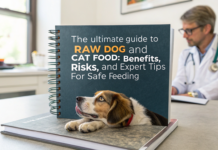Last Updated on October 15, 2023 by Dogs Vets
How Long Can Dogs Go Without Food?
If you are a dog owner, you may have wondered how long your furry friend can survive without food. Maybe you are planning a trip and want to know how much food to pack for your dog. Or maybe your dog is sick and has lost its appetite.
Whatever the reason, it is important to understand the nutritional needs of dogs and the risks of starvation.
Dogs are omnivorous animals, meaning they can eat both plant and animal foods. They need a balanced diet that provides them with protein, fat, carbohydrates, vitamins, minerals, and water.
The amount of food a dog needs depends on several factors, such as its age, size, breed, activity level, and health condition.
According to the Merck Veterinary Manual, an average adult dog needs about 30 calories per pound of body weight per day to maintain its normal weight and function.
However, this is only a general guideline and may vary depending on the individual dog. Some dogs may need more or less calories depending on their metabolism and lifestyle.
The same source also states that dogs can survive for about five days without food, but this may also vary depending on the individual dog and the circumstances.
Some factors that may affect how long a dog can go without food include:
– Water intake: Water is essential for life and dogs need to drink enough water to stay hydrated and prevent dehydration.
Dehydration can cause serious health problems and even death in dogs. Dogs can survive for about three days without water, but this may be shorter or longer depending on the temperature, humidity, and activity level of the dog.
– Body fat: Body fat is a source of energy and insulation for dogs. Dogs with more body fat can survive longer without food than dogs with less body fat. However, too much body fat can also be harmful and cause obesity-related diseases in dogs.
– Muscle mass: Muscle mass is another source of energy for dogs. Dogs with more muscle mass can survive longer without food than dogs with less muscle mass. However, muscle mass also requires more calories to maintain and can be lost quickly during starvation.
– Health condition: Health condition can affect how long a dog can go without food. Dogs that are sick, injured, or have chronic diseases may have a lower tolerance for starvation than healthy dogs. They may also have a lower appetite and a higher risk of complications from malnutrition.
– Stress level: Stress level can affect how long a dog can go without food. Dogs that are stressed, anxious, or depressed may have a lower appetite and a higher risk of losing weight than calm and happy dogs.
Stress can also impair the immune system and make dogs more susceptible to infections and diseases.
As you can see, there is no definitive answer to how long a dog can go without food. It depends on many factors and each dog is different. However, it is clear that starvation is not good for dogs and can cause serious harm to their health and well-being.
Therefore, it is advisable to feed your dog regularly and provide it with a nutritious and balanced diet that meets its needs.
If your dog refuses to eat for more than 24 hours, you should consult your veterinarian to find out the cause and the best course of action.
Do not try to force-feed your dog or give it human foods that may be harmful or toxic to it.
Remember that your dog relies on you for its survival and happiness. Feeding your dog properly is one of the best ways to show your love and care for your canine companion.
Dehydration is more dangerous than hunger in dogs
Dehydration is a serious condition that can affect dogs of any age, breed, or size.
It occurs when the body loses more water than it takes in, resulting in a lack of fluids and electrolytes that are essential for normal functioning.
Dehydration can cause a variety of symptoms, such as lethargy, dry mouth, sunken eyes, loss of appetite, decreased skin elasticity, and increased heart rate. If left untreated, dehydration can lead to organ failure, shock, and even death.
Dehydration is more dangerous than hunger in dogs because dogs can survive for several days without food, but only a few hours without water.
Water is vital for many bodily processes, such as digestion, circulation, temperature regulation, and waste elimination.
Without water, these processes are disrupted and the body becomes unable to maintain homeostasis.
Furthermore, dehydration can worsen the effects of hunger by making the dog more susceptible to infections, parasites, and diseases.
The most common causes of dehydration in dogs are vomiting, diarrhea, excessive urination, fever, heat stroke, and insufficient water intake.
Some dogs may also become dehydrated due to underlying medical conditions, such as kidney disease, diabetes, or cancer.
To prevent dehydration, owners should provide their dogs with fresh, clean water at all times and monitor their hydration status regularly.
Dog owners should also seek veterinary attention if their dogs show signs of dehydration or have any of the risk factors mentioned above.
If your dog is refusing to drink water, he or she may be suffering from heat exhaustion.
Dehydration can also be caused by other problems, including diarrhea, kidney disease, and diabetes.
If your dog is showing signs of dehydration, give it water immediately.
However, make sure to give it the water gradually, in order to avoid vomiting. If your dog does not drink water, take it to the vet right away.
Your vet will be able to give him or her intravenous fluids and treat the underlying condition. While this treatment may seem to be effective, it might not be enough to cure your dog.
If your dog is vomiting and has diarrhea, seek veterinary care as soon as possible.
If your dog is severely dehydrated, the vet may be able to give him or her an electrolytic solution to keep him or her hydrated.
In more severe cases, IV fluids may be necessary. A dog that has been exercising for a long time or has had intense physical activity may need more fluids than a healthy dog.
In severe cases, canine dehydration can result in organ failure and death. The body does not receive enough water, leading to a lack of electrolytes.
If your dog does not drink enough water, he or she will not be able to urinate.
Dehydration is more serious than hunger for dogs and should be treated as soon as possible. If you leave your dog with your dog for a long period of time, ensure you leave them a bowl of fresh water and some food.
Water intake is more important than food intake in dogs
Dogs are mammals that require adequate hydration to maintain their health and well-being. Water is essential for many physiological processes, such as digestion, circulation, temperature regulation, waste elimination, and joint lubrication.
Without enough water, dogs can suffer from dehydration, which can lead to serious complications such as kidney failure, shock, and even death.
Food intake is also important for dogs, as it provides them with the energy and nutrients they need to grow, repair, and function.
However, food intake is not as critical as water intake in terms of survival. Dogs can survive for several weeks without food, but only a few days without water. Therefore, water intake is more important than food intake in dogs.
To ensure that your dog stays hydrated, you should provide them with fresh, clean water at all times. You should also monitor their water consumption and look for signs of dehydration, such as dry mouth, sunken eyes, lethargy, and loss of skin elasticity.
If you notice any of these symptoms, you should contact your veterinarian immediately.
You should also consult your veterinarian about the appropriate amount and type of food for your dog, based on their age, size, breed, activity level, and health condition.
Water transports oxygen and nutrients to cells, lubricates joints and protects internal organs.
The human body is approximately 70 percent water, and dogs need the same amount of water to maintain health. However, water intake is often overlooked when it comes to feeding your dog.
Typically, a 20-pound dog should drink one ounce of water for every pound of body weight.
However, this may change with age, breed, size, and any existing health issues your dog may have. Dogs may need more water during the warmer months or during a heat wave.
Keeping an eye on the water bowl can help you monitor the amount your dog is drinking.
If you notice significant changes in the amount of water your dog drinks, it’s important to get your dog checked.
Just as humans need plenty of food to stay healthy, dogs need adequate water to maintain proper body temperature.
Water aids in digestion, moves nutrients in and out of the cells, and maintains normal body temperature. Water also cushions and lubricates joints so your pooch can move freely without pain.
Moreover, water helps with elimination, making it essential for proper functioning of internal organs and other bodily functions.
When dogs refuse to drink water, it may be a sign of a behavioural issue, which manifests itself in excessive thirst. This condition is most common among dogs that are stressed, bored, or breeds that enjoy water.
A dog may refuse to drink water if it smells foreign to him. If you notice this in your dog, add some water to its meals. This will help increase its water intake.
Reasons a dog won’t eat
There are many possible reasons why a dog won’t eat. Some of them are related to the dog’s health, such as dental problems, gastrointestinal issues, infections, parasites, allergies, or chronic diseases.
Others are related to the dog’s environment, such as stress, anxiety, boredom, changes in routine, or unfamiliar food. Sometimes, a dog may refuse to eat because of behavioral issues, such as being picky, spoiled, or dominant.
It is important to identify the cause of the dog’s loss of appetite and consult a veterinarian if necessary. A dog that won’t eat may become dehydrated, malnourished, or weak, and may develop serious complications.
Therefore, owners should monitor their dog’s eating habits and provide them with a balanced diet that meets their nutritional needs and preferences.
If you notice a change in your dog’s eating habits, consult with a veterinarian for further evaluation.
One reason a dog won’t eat is because of a physical issue. While anorexia in humans is a serious condition, anorexia in animals is a more common problem than you might think.
The difference between true anorexia and pseudo-anorexia is that true anorexia refers to a dog’s inability to eat, while pseudo-anorexia is a condition in which a dog wants to eat but cannot because it is unable to.
It could be the result of a gastrointestinal problem or a physical issue that prevents the dog from swallowing.
If your dog refuses to eat, consult a veterinarian. They can rule out underlying medical conditions that could be causing an inability to eat.
Do not give your pet any over-the-counter medications for gastrointestinal problems unless it has been prescribed by a vet.
If the problem persists for more than 24 hours, consult a veterinarian. By identifying the underlying cause of your dog’s poor appetite, you can encourage your pet to eat again.
It’s dangerous to let your dog go more than a day without food or nourishment?
If your dog has a sudden illness, letting him go longer than a day without food may be dangerous for both of you.
Leaving your dog for more than 12 hours without food will cause him to suffer dehydration and hypoglycemia, which is life-threatening for small breed puppies. A healthy dog cannot survive for more than a day without food or water.
If you let him go longer than a day without food or water, you will need to take immediate action to make sure that he gets proper nutrition.
If you don’t see signs of dehydration in your dog, you can try to help him by leaving food out for him to graze on.
Dogs are very active and can go a day without food if they are not in pain. Try to offer your dog bland home cooked food that is easy to digest.
You can also try to provide smaller meals more frequently. Don’t force your dog to eat something new, because this may upset its stomach.
The best way to handle this is to take him to a vet as soon as you notice your dog going longer than a day without food. Although your dog may seem fine, the signs of dehydration can be serious and require immediate attention.
A lack of appetite may signal a serious underlying condition such as an infection or an obstruction, or it could be simply a symptom of a digestive problem.
If you don’t have the time to visit a veterinarian, you can start experimenting with a timed feeding method. This method allows you to set a timer for each meal and then remove the food bowl after the specified time.
Depending on your dog’s weight and activity level, you can gradually increase the time for presenting food. Aim for between 5% and 10% of your dog’s daily intake with treats.
Dog may refuse to eat: Solution & Treatment Options
`
There are many possible reasons why a dog may refuse to eat, such as stress, illness, pain, dental problems, or picky preferences.
However, not eating can have serious consequences for a dog’s health, especially if they have a chronic condition that requires medication or a special diet.
Therefore, it is important to consult a veterinarian if your dog stops eating for more than a day or two, and to try some of the following treatment options to encourage them to eat:
- Offer them their favorite food or a different type of food, such as wet food, dry food, or human food (but make sure it is safe and nutritious for dogs).
- Add some water, broth, or gravy to their food to make it more moist and palatable.
- Warm up their food slightly to enhance the aroma and flavor.
- Hand-feed them or use a syringe to gently squirt some food into their mouth.
- Stimulate their appetite with some natural remedies, such as ginger, parsley, or bone broth.
- Reduce any stress or anxiety that may be affecting their appetite, such as loud noises, unfamiliar people or animals, or changes in their routine or environment.
- Give them some treats or toys to reward them for eating or to distract them from any discomfort or fear.
- Ask your veterinarian about appetite stimulants, anti-nausea medications, or pain relievers that may help your dog eat more comfortably and willingly.
These are some of the treatment options that may help your dog eat if they are refusing to do so. However, remember that not eating can be a sign of a serious underlying problem that needs medical attention.
Therefore, always consult your veterinarian before trying any of these options and monitor your dog’s condition closely. By doing so, you can help your dog recover and enjoy their food again.
Inappetence can be a sign of something serious, such as pancreatitis, kidney failure, or a tumor.
If your dog refuses food or water for more than two days, it’s best to take him to a vet, not only for the pet’s sake, but also for your own peace of mind.
A vet will diagnose the problem and make sure you’re not worried for no reason.
Your veterinarian may recommend additional testing, including a blood test, to rule out underlying medical conditions. Over-the-counter gastrointestinal medicines should not be given to your dog.
Such medications can have serious side effects, or interact with any medication your veterinarian has given.
Rather than rushing to the vet to treat the problem, consult a veterinarian to ensure your pet’s well-being. A veterinarian can recommend a treatment plan that is tailored to the individual’s condition.
Questions people are asking
Can a dog survive three days without food?
The majority of healthy canines can survive three days without food. Many can even survive for five days, while others can endure seven. This assumes that they continue to consume water. If your dog is unhealthy, he can certainly survive up to three days without food.
Can a dog survive without food for four days?
Every dog is different, and there is no “safe” number of days for dogs on hunger strike; nevertheless, most healthy dogs may survive three days without eating as long as they drink water.
What happens if a dog goes four days without eating?
Anorexia is a life-threatening disorder in dogs. Untreated for several days, this condition can result in malnutrition and dehydration.
Even if your dog or puppy is functioning normally, you should contact your veterinarian immediately if it refuses to eat.
🌐 Sources
- Raised Right Pets – How Long Can A Dog Go Without Eating? A Vet Answers
- A-Z Animals – This Is How Long Your Dog Can Go without Eating, and When It’s Dangerous
Facts Check
We hope you enjoyed this article… What are your thoughts on How Long Can Dogs Go Without Food?
Please feel free to share this article!

















